Psychological Interventions for Injured Athletes
VerifiedAdded on 2020/05/28
|10
|2571
|286
AI Summary
This assignment explores the impact of psychological interventions on injured athletes aged 17 and below. It aims to determine if these interventions effectively reduce post-surgery symptoms and enhance their psychological coping abilities during recovery. The research will employ qualitative data analysis methods, comparing randomized control trials with non-randomized control trials before and after intervention implementation. Interviews and observations will be used to collect data on participants' experiences and feelings throughout the recovery process.
Contribute Materials
Your contribution can guide someone’s learning journey. Share your
documents today.

Running head: LITERATURE REVIEW
LITERATURE REVIEW
[Author Name(s), First M. Last, Omit Titles and Degrees]
[Institutional Affiliation(s)]
LITERATURE REVIEW
[Author Name(s), First M. Last, Omit Titles and Degrees]
[Institutional Affiliation(s)]
Secure Best Marks with AI Grader
Need help grading? Try our AI Grader for instant feedback on your assignments.
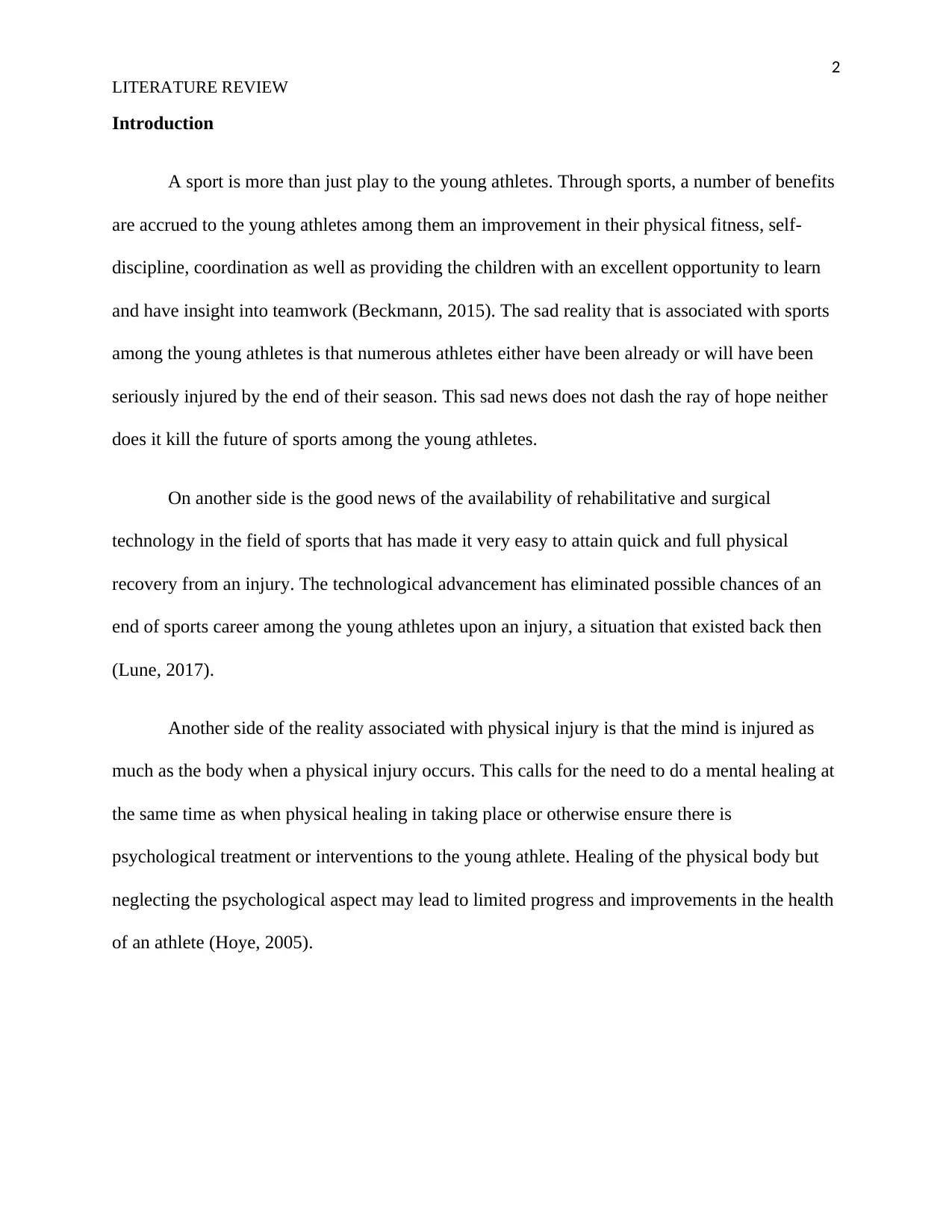
2
LITERATURE REVIEW
Introduction
A sport is more than just play to the young athletes. Through sports, a number of benefits
are accrued to the young athletes among them an improvement in their physical fitness, self-
discipline, coordination as well as providing the children with an excellent opportunity to learn
and have insight into teamwork (Beckmann, 2015). The sad reality that is associated with sports
among the young athletes is that numerous athletes either have been already or will have been
seriously injured by the end of their season. This sad news does not dash the ray of hope neither
does it kill the future of sports among the young athletes.
On another side is the good news of the availability of rehabilitative and surgical
technology in the field of sports that has made it very easy to attain quick and full physical
recovery from an injury. The technological advancement has eliminated possible chances of an
end of sports career among the young athletes upon an injury, a situation that existed back then
(Lune, 2017).
Another side of the reality associated with physical injury is that the mind is injured as
much as the body when a physical injury occurs. This calls for the need to do a mental healing at
the same time as when physical healing in taking place or otherwise ensure there is
psychological treatment or interventions to the young athlete. Healing of the physical body but
neglecting the psychological aspect may lead to limited progress and improvements in the health
of an athlete (Hoye, 2005).
LITERATURE REVIEW
Introduction
A sport is more than just play to the young athletes. Through sports, a number of benefits
are accrued to the young athletes among them an improvement in their physical fitness, self-
discipline, coordination as well as providing the children with an excellent opportunity to learn
and have insight into teamwork (Beckmann, 2015). The sad reality that is associated with sports
among the young athletes is that numerous athletes either have been already or will have been
seriously injured by the end of their season. This sad news does not dash the ray of hope neither
does it kill the future of sports among the young athletes.
On another side is the good news of the availability of rehabilitative and surgical
technology in the field of sports that has made it very easy to attain quick and full physical
recovery from an injury. The technological advancement has eliminated possible chances of an
end of sports career among the young athletes upon an injury, a situation that existed back then
(Lune, 2017).
Another side of the reality associated with physical injury is that the mind is injured as
much as the body when a physical injury occurs. This calls for the need to do a mental healing at
the same time as when physical healing in taking place or otherwise ensure there is
psychological treatment or interventions to the young athlete. Healing of the physical body but
neglecting the psychological aspect may lead to limited progress and improvements in the health
of an athlete (Hoye, 2005).
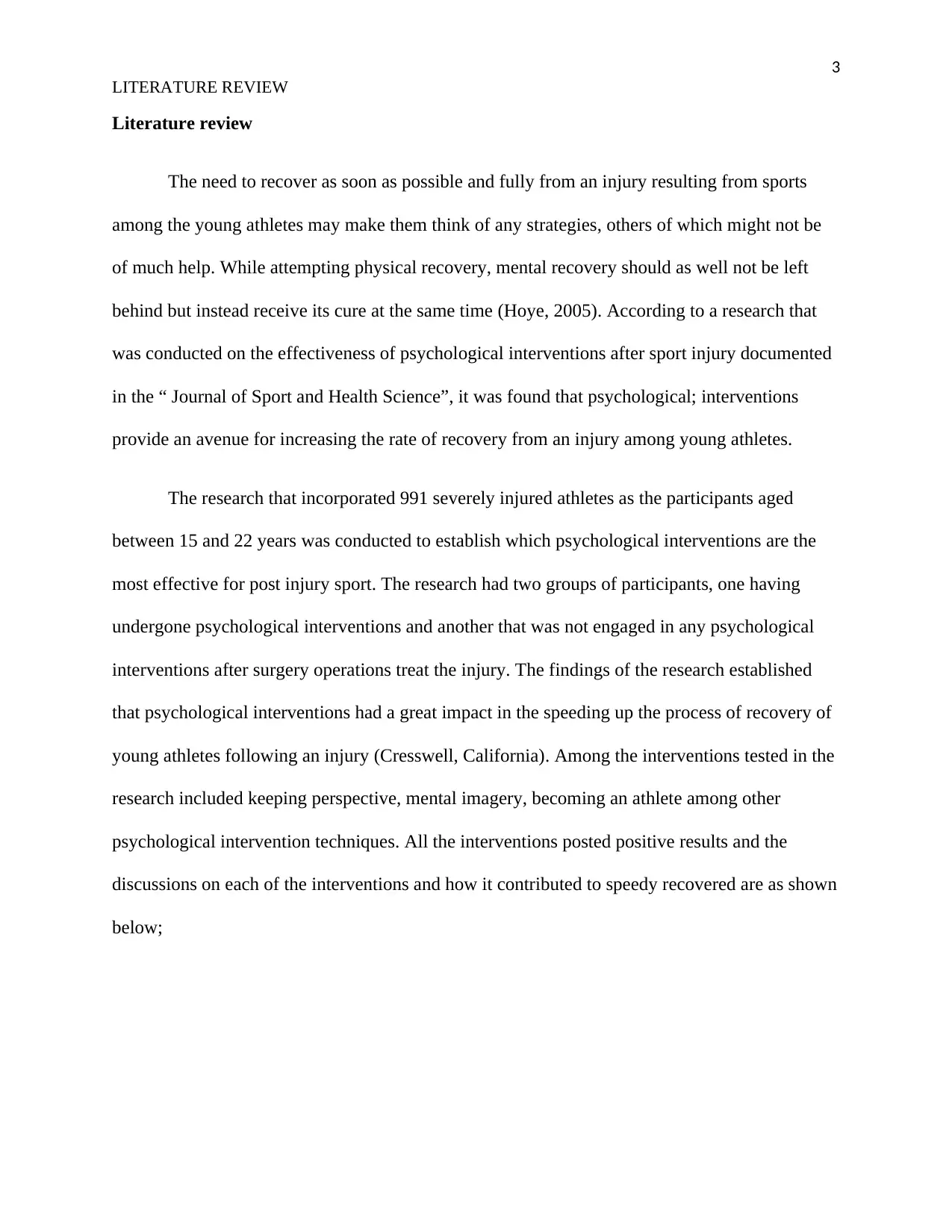
3
LITERATURE REVIEW
Literature review
The need to recover as soon as possible and fully from an injury resulting from sports
among the young athletes may make them think of any strategies, others of which might not be
of much help. While attempting physical recovery, mental recovery should as well not be left
behind but instead receive its cure at the same time (Hoye, 2005). According to a research that
was conducted on the effectiveness of psychological interventions after sport injury documented
in the “ Journal of Sport and Health Science”, it was found that psychological; interventions
provide an avenue for increasing the rate of recovery from an injury among young athletes.
The research that incorporated 991 severely injured athletes as the participants aged
between 15 and 22 years was conducted to establish which psychological interventions are the
most effective for post injury sport. The research had two groups of participants, one having
undergone psychological interventions and another that was not engaged in any psychological
interventions after surgery operations treat the injury. The findings of the research established
that psychological interventions had a great impact in the speeding up the process of recovery of
young athletes following an injury (Cresswell, California). Among the interventions tested in the
research included keeping perspective, mental imagery, becoming an athlete among other
psychological intervention techniques. All the interventions posted positive results and the
discussions on each of the interventions and how it contributed to speedy recovered are as shown
below;
LITERATURE REVIEW
Literature review
The need to recover as soon as possible and fully from an injury resulting from sports
among the young athletes may make them think of any strategies, others of which might not be
of much help. While attempting physical recovery, mental recovery should as well not be left
behind but instead receive its cure at the same time (Hoye, 2005). According to a research that
was conducted on the effectiveness of psychological interventions after sport injury documented
in the “ Journal of Sport and Health Science”, it was found that psychological; interventions
provide an avenue for increasing the rate of recovery from an injury among young athletes.
The research that incorporated 991 severely injured athletes as the participants aged
between 15 and 22 years was conducted to establish which psychological interventions are the
most effective for post injury sport. The research had two groups of participants, one having
undergone psychological interventions and another that was not engaged in any psychological
interventions after surgery operations treat the injury. The findings of the research established
that psychological interventions had a great impact in the speeding up the process of recovery of
young athletes following an injury (Cresswell, California). Among the interventions tested in the
research included keeping perspective, mental imagery, becoming an athlete among other
psychological intervention techniques. All the interventions posted positive results and the
discussions on each of the interventions and how it contributed to speedy recovered are as shown
below;
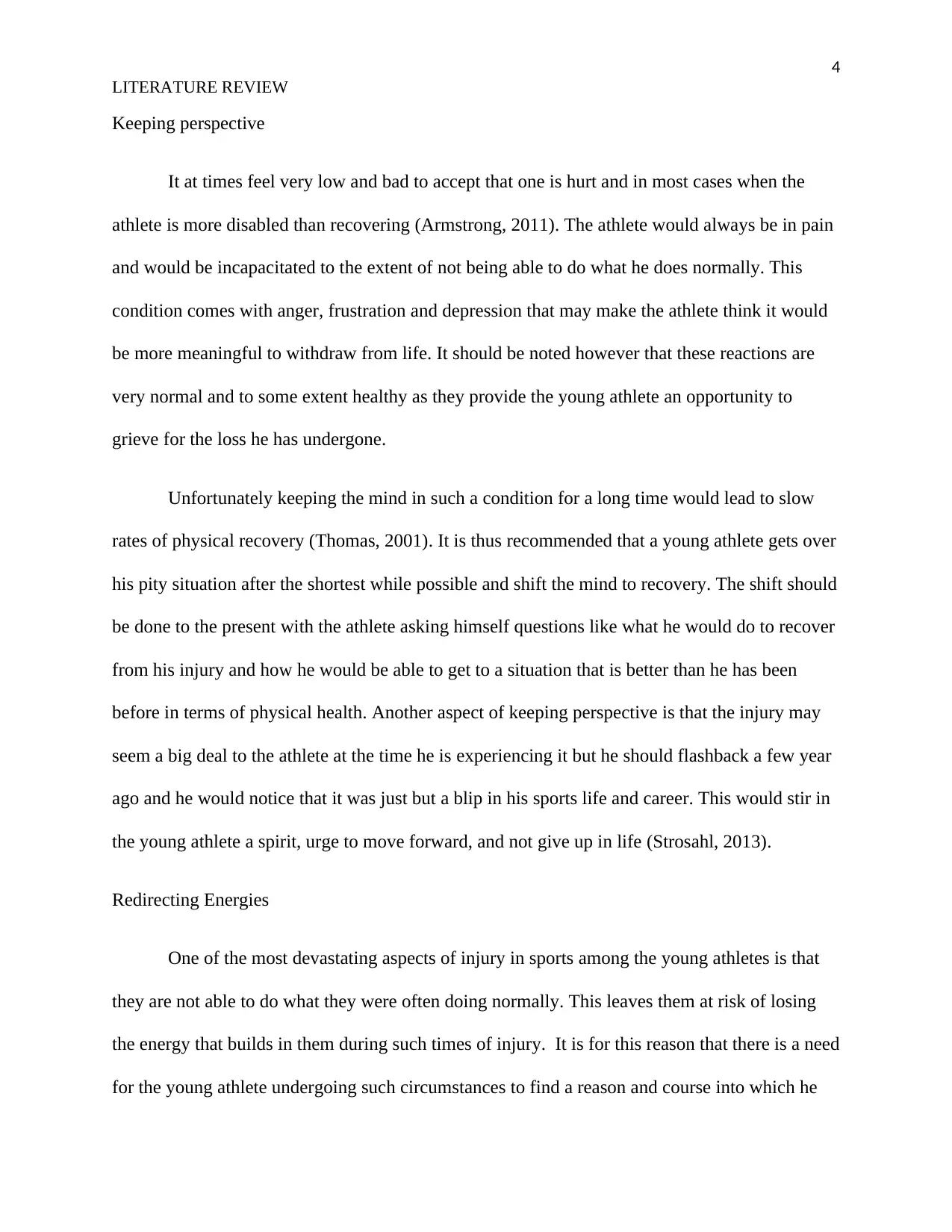
4
LITERATURE REVIEW
Keeping perspective
It at times feel very low and bad to accept that one is hurt and in most cases when the
athlete is more disabled than recovering (Armstrong, 2011). The athlete would always be in pain
and would be incapacitated to the extent of not being able to do what he does normally. This
condition comes with anger, frustration and depression that may make the athlete think it would
be more meaningful to withdraw from life. It should be noted however that these reactions are
very normal and to some extent healthy as they provide the young athlete an opportunity to
grieve for the loss he has undergone.
Unfortunately keeping the mind in such a condition for a long time would lead to slow
rates of physical recovery (Thomas, 2001). It is thus recommended that a young athlete gets over
his pity situation after the shortest while possible and shift the mind to recovery. The shift should
be done to the present with the athlete asking himself questions like what he would do to recover
from his injury and how he would be able to get to a situation that is better than he has been
before in terms of physical health. Another aspect of keeping perspective is that the injury may
seem a big deal to the athlete at the time he is experiencing it but he should flashback a few year
ago and he would notice that it was just but a blip in his sports life and career. This would stir in
the young athlete a spirit, urge to move forward, and not give up in life (Strosahl, 2013).
Redirecting Energies
One of the most devastating aspects of injury in sports among the young athletes is that
they are not able to do what they were often doing normally. This leaves them at risk of losing
the energy that builds in them during such times of injury. It is for this reason that there is a need
for the young athlete undergoing such circumstances to find a reason and course into which he
LITERATURE REVIEW
Keeping perspective
It at times feel very low and bad to accept that one is hurt and in most cases when the
athlete is more disabled than recovering (Armstrong, 2011). The athlete would always be in pain
and would be incapacitated to the extent of not being able to do what he does normally. This
condition comes with anger, frustration and depression that may make the athlete think it would
be more meaningful to withdraw from life. It should be noted however that these reactions are
very normal and to some extent healthy as they provide the young athlete an opportunity to
grieve for the loss he has undergone.
Unfortunately keeping the mind in such a condition for a long time would lead to slow
rates of physical recovery (Thomas, 2001). It is thus recommended that a young athlete gets over
his pity situation after the shortest while possible and shift the mind to recovery. The shift should
be done to the present with the athlete asking himself questions like what he would do to recover
from his injury and how he would be able to get to a situation that is better than he has been
before in terms of physical health. Another aspect of keeping perspective is that the injury may
seem a big deal to the athlete at the time he is experiencing it but he should flashback a few year
ago and he would notice that it was just but a blip in his sports life and career. This would stir in
the young athlete a spirit, urge to move forward, and not give up in life (Strosahl, 2013).
Redirecting Energies
One of the most devastating aspects of injury in sports among the young athletes is that
they are not able to do what they were often doing normally. This leaves them at risk of losing
the energy that builds in them during such times of injury. It is for this reason that there is a need
for the young athlete undergoing such circumstances to find a reason and course into which he
Secure Best Marks with AI Grader
Need help grading? Try our AI Grader for instant feedback on your assignments.
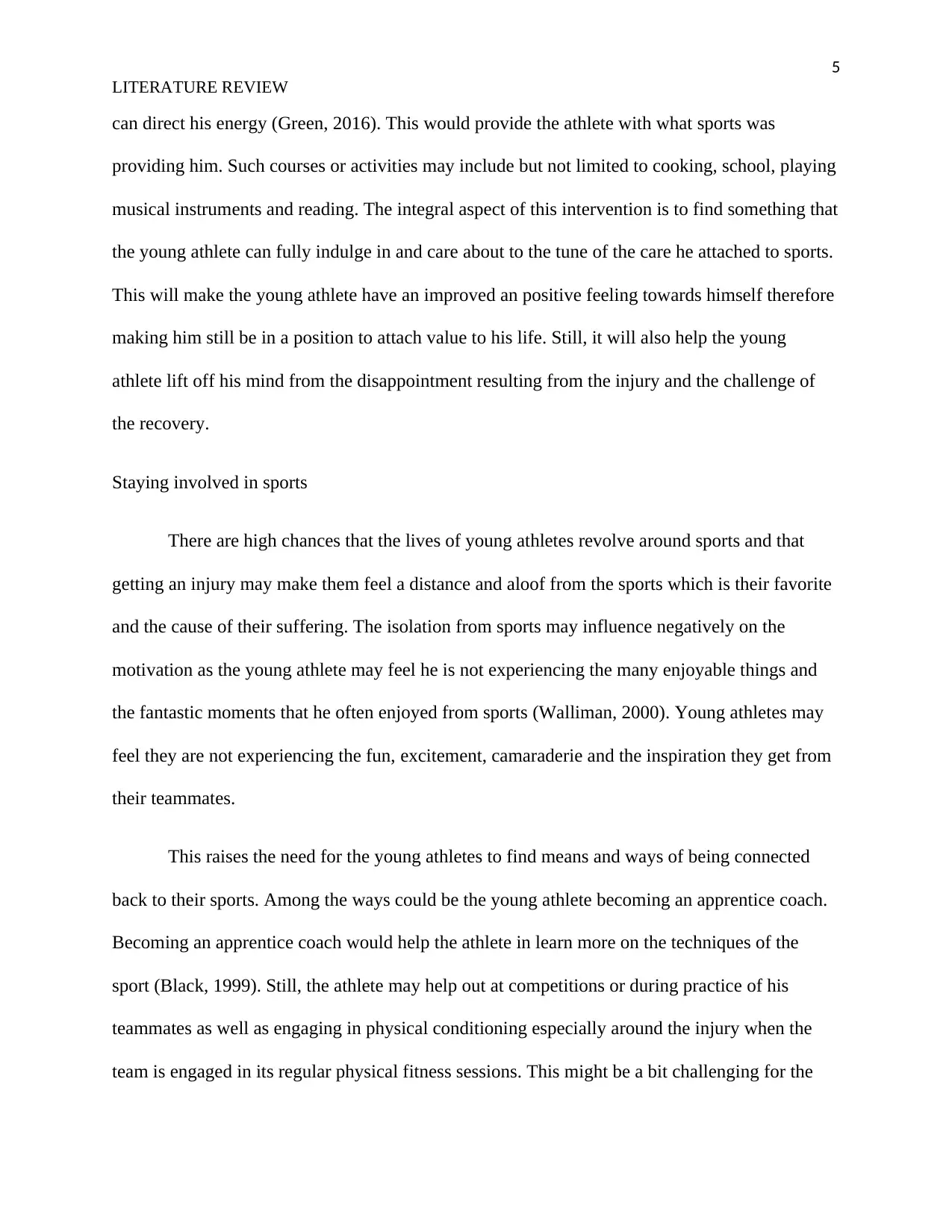
5
LITERATURE REVIEW
can direct his energy (Green, 2016). This would provide the athlete with what sports was
providing him. Such courses or activities may include but not limited to cooking, school, playing
musical instruments and reading. The integral aspect of this intervention is to find something that
the young athlete can fully indulge in and care about to the tune of the care he attached to sports.
This will make the young athlete have an improved an positive feeling towards himself therefore
making him still be in a position to attach value to his life. Still, it will also help the young
athlete lift off his mind from the disappointment resulting from the injury and the challenge of
the recovery.
Staying involved in sports
There are high chances that the lives of young athletes revolve around sports and that
getting an injury may make them feel a distance and aloof from the sports which is their favorite
and the cause of their suffering. The isolation from sports may influence negatively on the
motivation as the young athlete may feel he is not experiencing the many enjoyable things and
the fantastic moments that he often enjoyed from sports (Walliman, 2000). Young athletes may
feel they are not experiencing the fun, excitement, camaraderie and the inspiration they get from
their teammates.
This raises the need for the young athletes to find means and ways of being connected
back to their sports. Among the ways could be the young athlete becoming an apprentice coach.
Becoming an apprentice coach would help the athlete in learn more on the techniques of the
sport (Black, 1999). Still, the athlete may help out at competitions or during practice of his
teammates as well as engaging in physical conditioning especially around the injury when the
team is engaged in its regular physical fitness sessions. This might be a bit challenging for the
LITERATURE REVIEW
can direct his energy (Green, 2016). This would provide the athlete with what sports was
providing him. Such courses or activities may include but not limited to cooking, school, playing
musical instruments and reading. The integral aspect of this intervention is to find something that
the young athlete can fully indulge in and care about to the tune of the care he attached to sports.
This will make the young athlete have an improved an positive feeling towards himself therefore
making him still be in a position to attach value to his life. Still, it will also help the young
athlete lift off his mind from the disappointment resulting from the injury and the challenge of
the recovery.
Staying involved in sports
There are high chances that the lives of young athletes revolve around sports and that
getting an injury may make them feel a distance and aloof from the sports which is their favorite
and the cause of their suffering. The isolation from sports may influence negatively on the
motivation as the young athlete may feel he is not experiencing the many enjoyable things and
the fantastic moments that he often enjoyed from sports (Walliman, 2000). Young athletes may
feel they are not experiencing the fun, excitement, camaraderie and the inspiration they get from
their teammates.
This raises the need for the young athletes to find means and ways of being connected
back to their sports. Among the ways could be the young athlete becoming an apprentice coach.
Becoming an apprentice coach would help the athlete in learn more on the techniques of the
sport (Black, 1999). Still, the athlete may help out at competitions or during practice of his
teammates as well as engaging in physical conditioning especially around the injury when the
team is engaged in its regular physical fitness sessions. This might be a bit challenging for the
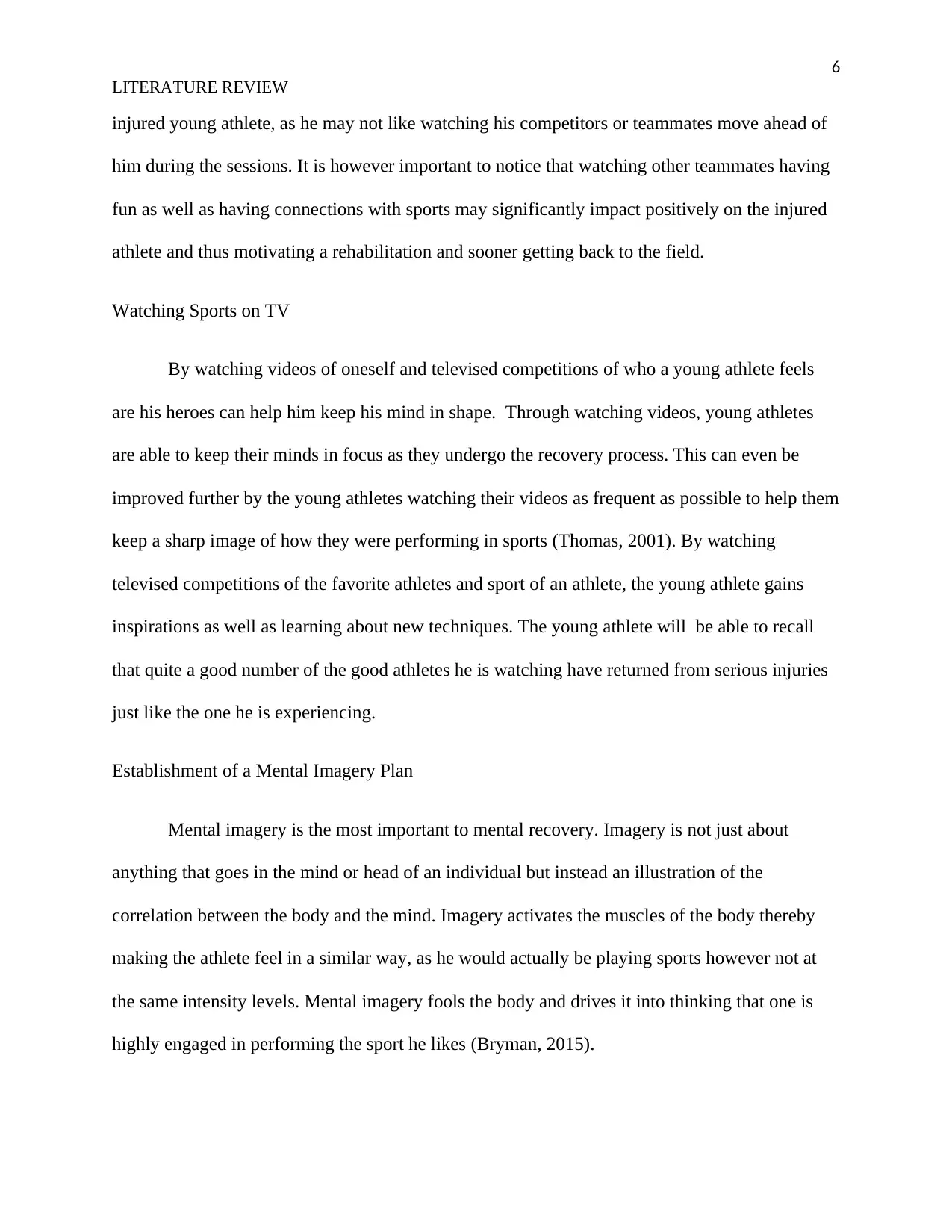
6
LITERATURE REVIEW
injured young athlete, as he may not like watching his competitors or teammates move ahead of
him during the sessions. It is however important to notice that watching other teammates having
fun as well as having connections with sports may significantly impact positively on the injured
athlete and thus motivating a rehabilitation and sooner getting back to the field.
Watching Sports on TV
By watching videos of oneself and televised competitions of who a young athlete feels
are his heroes can help him keep his mind in shape. Through watching videos, young athletes
are able to keep their minds in focus as they undergo the recovery process. This can even be
improved further by the young athletes watching their videos as frequent as possible to help them
keep a sharp image of how they were performing in sports (Thomas, 2001). By watching
televised competitions of the favorite athletes and sport of an athlete, the young athlete gains
inspirations as well as learning about new techniques. The young athlete will be able to recall
that quite a good number of the good athletes he is watching have returned from serious injuries
just like the one he is experiencing.
Establishment of a Mental Imagery Plan
Mental imagery is the most important to mental recovery. Imagery is not just about
anything that goes in the mind or head of an individual but instead an illustration of the
correlation between the body and the mind. Imagery activates the muscles of the body thereby
making the athlete feel in a similar way, as he would actually be playing sports however not at
the same intensity levels. Mental imagery fools the body and drives it into thinking that one is
highly engaged in performing the sport he likes (Bryman, 2015).
LITERATURE REVIEW
injured young athlete, as he may not like watching his competitors or teammates move ahead of
him during the sessions. It is however important to notice that watching other teammates having
fun as well as having connections with sports may significantly impact positively on the injured
athlete and thus motivating a rehabilitation and sooner getting back to the field.
Watching Sports on TV
By watching videos of oneself and televised competitions of who a young athlete feels
are his heroes can help him keep his mind in shape. Through watching videos, young athletes
are able to keep their minds in focus as they undergo the recovery process. This can even be
improved further by the young athletes watching their videos as frequent as possible to help them
keep a sharp image of how they were performing in sports (Thomas, 2001). By watching
televised competitions of the favorite athletes and sport of an athlete, the young athlete gains
inspirations as well as learning about new techniques. The young athlete will be able to recall
that quite a good number of the good athletes he is watching have returned from serious injuries
just like the one he is experiencing.
Establishment of a Mental Imagery Plan
Mental imagery is the most important to mental recovery. Imagery is not just about
anything that goes in the mind or head of an individual but instead an illustration of the
correlation between the body and the mind. Imagery activates the muscles of the body thereby
making the athlete feel in a similar way, as he would actually be playing sports however not at
the same intensity levels. Mental imagery fools the body and drives it into thinking that one is
highly engaged in performing the sport he likes (Bryman, 2015).
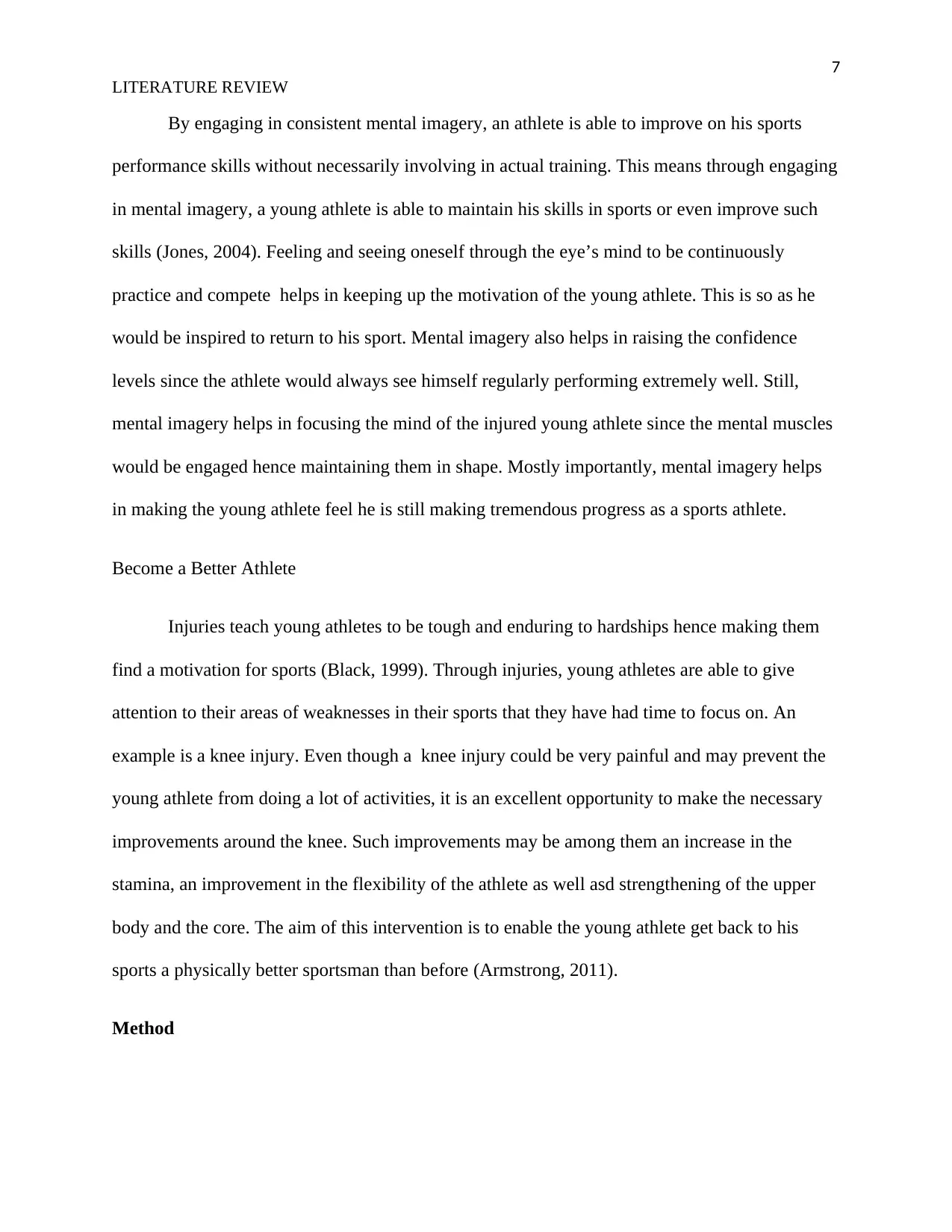
7
LITERATURE REVIEW
By engaging in consistent mental imagery, an athlete is able to improve on his sports
performance skills without necessarily involving in actual training. This means through engaging
in mental imagery, a young athlete is able to maintain his skills in sports or even improve such
skills (Jones, 2004). Feeling and seeing oneself through the eye’s mind to be continuously
practice and compete helps in keeping up the motivation of the young athlete. This is so as he
would be inspired to return to his sport. Mental imagery also helps in raising the confidence
levels since the athlete would always see himself regularly performing extremely well. Still,
mental imagery helps in focusing the mind of the injured young athlete since the mental muscles
would be engaged hence maintaining them in shape. Mostly importantly, mental imagery helps
in making the young athlete feel he is still making tremendous progress as a sports athlete.
Become a Better Athlete
Injuries teach young athletes to be tough and enduring to hardships hence making them
find a motivation for sports (Black, 1999). Through injuries, young athletes are able to give
attention to their areas of weaknesses in their sports that they have had time to focus on. An
example is a knee injury. Even though a knee injury could be very painful and may prevent the
young athlete from doing a lot of activities, it is an excellent opportunity to make the necessary
improvements around the knee. Such improvements may be among them an increase in the
stamina, an improvement in the flexibility of the athlete as well asd strengthening of the upper
body and the core. The aim of this intervention is to enable the young athlete get back to his
sports a physically better sportsman than before (Armstrong, 2011).
Method
LITERATURE REVIEW
By engaging in consistent mental imagery, an athlete is able to improve on his sports
performance skills without necessarily involving in actual training. This means through engaging
in mental imagery, a young athlete is able to maintain his skills in sports or even improve such
skills (Jones, 2004). Feeling and seeing oneself through the eye’s mind to be continuously
practice and compete helps in keeping up the motivation of the young athlete. This is so as he
would be inspired to return to his sport. Mental imagery also helps in raising the confidence
levels since the athlete would always see himself regularly performing extremely well. Still,
mental imagery helps in focusing the mind of the injured young athlete since the mental muscles
would be engaged hence maintaining them in shape. Mostly importantly, mental imagery helps
in making the young athlete feel he is still making tremendous progress as a sports athlete.
Become a Better Athlete
Injuries teach young athletes to be tough and enduring to hardships hence making them
find a motivation for sports (Black, 1999). Through injuries, young athletes are able to give
attention to their areas of weaknesses in their sports that they have had time to focus on. An
example is a knee injury. Even though a knee injury could be very painful and may prevent the
young athlete from doing a lot of activities, it is an excellent opportunity to make the necessary
improvements around the knee. Such improvements may be among them an increase in the
stamina, an improvement in the flexibility of the athlete as well asd strengthening of the upper
body and the core. The aim of this intervention is to enable the young athlete get back to his
sports a physically better sportsman than before (Armstrong, 2011).
Method
Paraphrase This Document
Need a fresh take? Get an instant paraphrase of this document with our AI Paraphraser
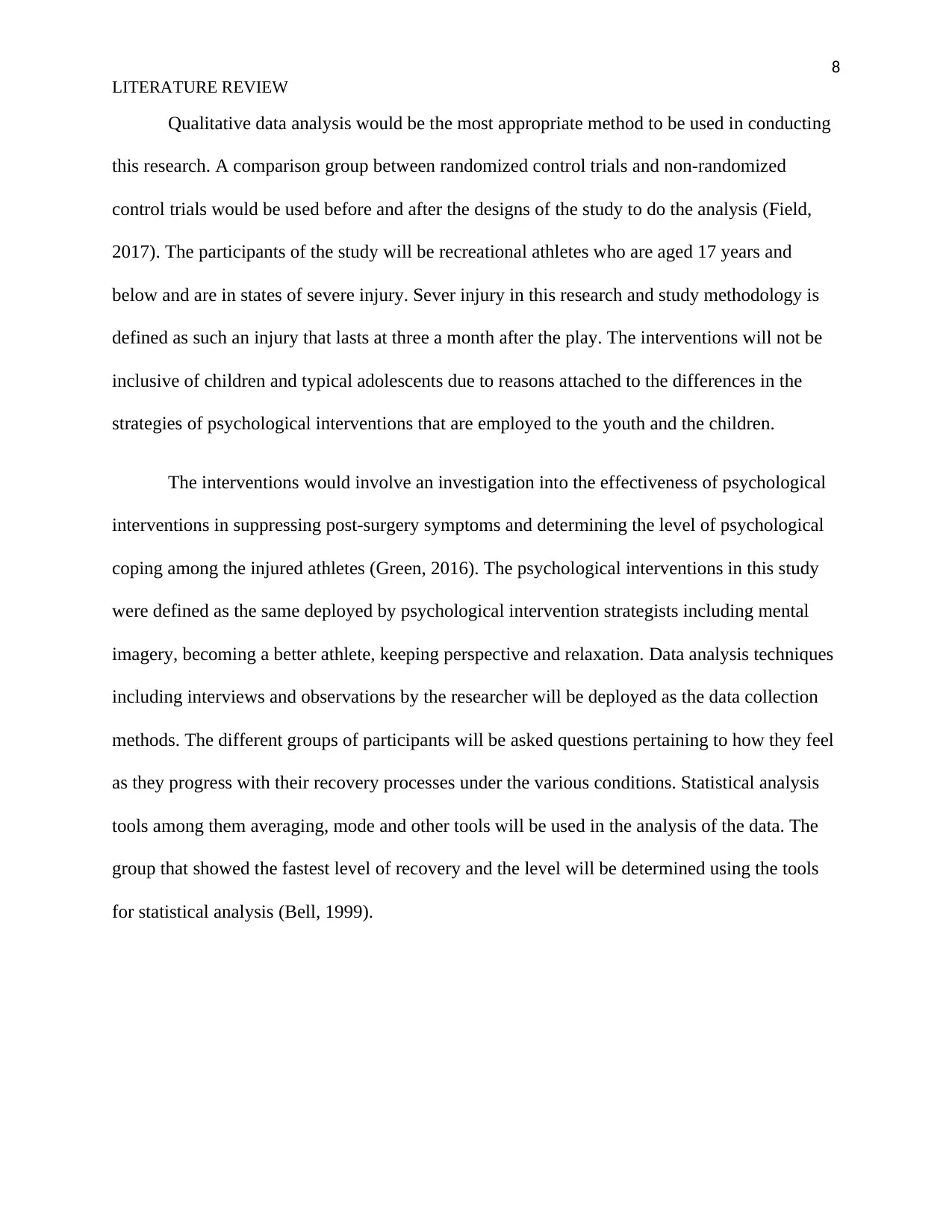
8
LITERATURE REVIEW
Qualitative data analysis would be the most appropriate method to be used in conducting
this research. A comparison group between randomized control trials and non-randomized
control trials would be used before and after the designs of the study to do the analysis (Field,
2017). The participants of the study will be recreational athletes who are aged 17 years and
below and are in states of severe injury. Sever injury in this research and study methodology is
defined as such an injury that lasts at three a month after the play. The interventions will not be
inclusive of children and typical adolescents due to reasons attached to the differences in the
strategies of psychological interventions that are employed to the youth and the children.
The interventions would involve an investigation into the effectiveness of psychological
interventions in suppressing post-surgery symptoms and determining the level of psychological
coping among the injured athletes (Green, 2016). The psychological interventions in this study
were defined as the same deployed by psychological intervention strategists including mental
imagery, becoming a better athlete, keeping perspective and relaxation. Data analysis techniques
including interviews and observations by the researcher will be deployed as the data collection
methods. The different groups of participants will be asked questions pertaining to how they feel
as they progress with their recovery processes under the various conditions. Statistical analysis
tools among them averaging, mode and other tools will be used in the analysis of the data. The
group that showed the fastest level of recovery and the level will be determined using the tools
for statistical analysis (Bell, 1999).
LITERATURE REVIEW
Qualitative data analysis would be the most appropriate method to be used in conducting
this research. A comparison group between randomized control trials and non-randomized
control trials would be used before and after the designs of the study to do the analysis (Field,
2017). The participants of the study will be recreational athletes who are aged 17 years and
below and are in states of severe injury. Sever injury in this research and study methodology is
defined as such an injury that lasts at three a month after the play. The interventions will not be
inclusive of children and typical adolescents due to reasons attached to the differences in the
strategies of psychological interventions that are employed to the youth and the children.
The interventions would involve an investigation into the effectiveness of psychological
interventions in suppressing post-surgery symptoms and determining the level of psychological
coping among the injured athletes (Green, 2016). The psychological interventions in this study
were defined as the same deployed by psychological intervention strategists including mental
imagery, becoming a better athlete, keeping perspective and relaxation. Data analysis techniques
including interviews and observations by the researcher will be deployed as the data collection
methods. The different groups of participants will be asked questions pertaining to how they feel
as they progress with their recovery processes under the various conditions. Statistical analysis
tools among them averaging, mode and other tools will be used in the analysis of the data. The
group that showed the fastest level of recovery and the level will be determined using the tools
for statistical analysis (Bell, 1999).

9
LITERATURE REVIEW
References
Armstrong, N. (2011). The Elite Young Athlete. Kansas: Karger Medical and Scientific
Publishers.
Beckmann, J. (2015). Sport Psychological Interventions in Competitive Sports. New York:
Cambridge Scholars Publishing.
Bell, J. (1999). Doing your Research Project: A Guide for First Time Researchers in Education.
London: Sage.
Berg., L. a. (2017). Qualitative Research Methods for Social Sciences. London: Pearson.
Black, T. (1999). Doing Quantitative Research in Social Sciences: An Integrated Approach.
London: Sage.
Bryman, A. (2015). Social Research Methods. Oxford: Oxford University Press.
Cresswell, J. (California). Research Design: Qualitative, Quantitative and Mixed Methods
Approaches. 2013: Sage.
Field, A. (2017). Discovering Statistics Using SPSS. London: Sage.
Graham, R. (2014). Sports-Related Concussions in Youth: Improving the Science, Changing the
Culture. Chicago: National Academies Press.
Green, K. (2016). Routledge Handbook of Youth Sport. London: Routledge.
Hoye, R. (2005). Sports Management. Oxford: Butterworth-Heinemann.
Jones, G. C. (2004). Research Methods for Sports Students. London: Roitledge.
LITERATURE REVIEW
References
Armstrong, N. (2011). The Elite Young Athlete. Kansas: Karger Medical and Scientific
Publishers.
Beckmann, J. (2015). Sport Psychological Interventions in Competitive Sports. New York:
Cambridge Scholars Publishing.
Bell, J. (1999). Doing your Research Project: A Guide for First Time Researchers in Education.
London: Sage.
Berg., L. a. (2017). Qualitative Research Methods for Social Sciences. London: Pearson.
Black, T. (1999). Doing Quantitative Research in Social Sciences: An Integrated Approach.
London: Sage.
Bryman, A. (2015). Social Research Methods. Oxford: Oxford University Press.
Cresswell, J. (California). Research Design: Qualitative, Quantitative and Mixed Methods
Approaches. 2013: Sage.
Field, A. (2017). Discovering Statistics Using SPSS. London: Sage.
Graham, R. (2014). Sports-Related Concussions in Youth: Improving the Science, Changing the
Culture. Chicago: National Academies Press.
Green, K. (2016). Routledge Handbook of Youth Sport. London: Routledge.
Hoye, R. (2005). Sports Management. Oxford: Butterworth-Heinemann.
Jones, G. C. (2004). Research Methods for Sports Students. London: Roitledge.

10
LITERATURE REVIEW
Khan, K. (2011). Brukner & Khan's Clinical Sports Medicine. Sydney: McGraw-Hill Education
Australia.
Strosahl, K. D. (2013). A Practical Guide to Acceptance and Commitment Therapy. New York:
Springer Science & Business Media.
Thomas, N. (2001). Research Methods for Physical Education. Leeds: Human Kinematics.
Walliman, N. (2000). Your Research Project: A Step-by-Step Guide for the First Time. London:
Sage.
Williams, C. (2003). Data Analysis and Research for Sport and Exercise Science: A Guide
Student. London: Routledge.
LITERATURE REVIEW
Khan, K. (2011). Brukner & Khan's Clinical Sports Medicine. Sydney: McGraw-Hill Education
Australia.
Strosahl, K. D. (2013). A Practical Guide to Acceptance and Commitment Therapy. New York:
Springer Science & Business Media.
Thomas, N. (2001). Research Methods for Physical Education. Leeds: Human Kinematics.
Walliman, N. (2000). Your Research Project: A Step-by-Step Guide for the First Time. London:
Sage.
Williams, C. (2003). Data Analysis and Research for Sport and Exercise Science: A Guide
Student. London: Routledge.
1 out of 10
Your All-in-One AI-Powered Toolkit for Academic Success.
+13062052269
info@desklib.com
Available 24*7 on WhatsApp / Email
![[object Object]](/_next/static/media/star-bottom.7253800d.svg)
Unlock your academic potential
© 2024 | Zucol Services PVT LTD | All rights reserved.

